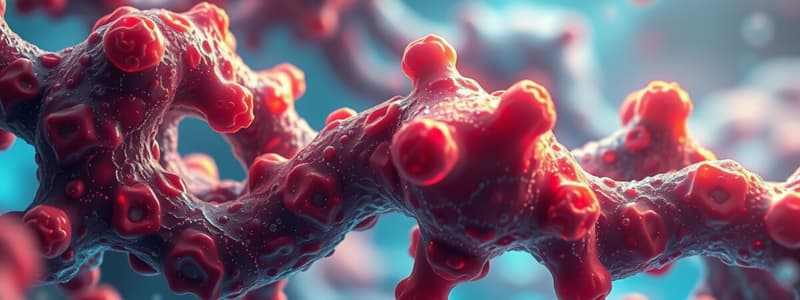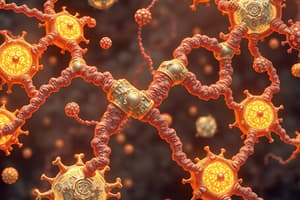Podcast
Questions and Answers
What is a catalyst?
What is a catalyst?
- Any chemical substance
- A type of enzyme that does not change (correct)
- A molecule that decreases the reaction time
- A substance that increases the rate of a chemical reaction (correct)
What are the functions of enzymes?
What are the functions of enzymes?
Enzymes speed up the rate of chemical reactions.
What type of biomolecule are enzymes?
What type of biomolecule are enzymes?
Proteins
How does the shape of an enzyme affect its function?
How does the shape of an enzyme affect its function?
Describe the lock and key mechanism model of enzyme structure.
Describe the lock and key mechanism model of enzyme structure.
How do enzymes speed up chemical reactions?
How do enzymes speed up chemical reactions?
What are the basic properties of enzymes?
What are the basic properties of enzymes?
What are the four basic biomolecules?
What are the four basic biomolecules?
What are the monomers of each biomolecule?
What are the monomers of each biomolecule?
What elements are each category of biomolecules composed of?
What elements are each category of biomolecules composed of?
What are some examples of the four macromolecules?
What are some examples of the four macromolecules?
Which biomolecules can store the most energy and why?
Which biomolecules can store the most energy and why?
What types of reactions bond monomers together?
What types of reactions bond monomers together?
What is the difference between monosaccharides, disaccharides, and polysaccharides?
What is the difference between monosaccharides, disaccharides, and polysaccharides?
What are some examples of each of the four macromolecules?
What are some examples of each of the four macromolecules?
What does CHO stand for?
What does CHO stand for?
What does CHON stand for?
What does CHON stand for?
What does CHON P stand for?
What does CHON P stand for?
Flashcards are hidden until you start studying
Study Notes
Enzymes and Catalysts
- Enzymes are biological catalysts that increase the rate of chemical reactions without undergoing permanent changes themselves.
- They are primarily proteins made from amino acid monomers, crucial for biological processes.
Enzyme Structure and Function
- Enzyme shape is critical as it determines how effectively a substrate can bind and be catalyzed.
- The "lock and key" model illustrates that only a specific substrate (key) can fit into the enzyme's active site (lock).
Mechanism of Action
- Enzymes lower the activation energy required for a reaction, facilitating quicker transitions from reactants to products.
- They maintain their mass and chemical composition post-reaction, allowing them to be reused.
Biological Macromolecules
- Four main types of biomolecules: carbohydrates, lipids, proteins, and nucleic acids, each serving vital roles within organisms.
- Each macromolecule is composed of specific monomers:
- Carbohydrates consist of monosaccharides.
- Lipids include glycerol and fatty acids.
- Nucleic acids are made from nucleotides.
- Proteins are made of amino acids.
Composition of Biomolecules
- Carbohydrates are composed of carbon (C), hydrogen (H), and oxygen (O).
- Proteins are mainly carbon, hydrogen, oxygen, and nitrogen (CHON).
- Lipids also follow a CHO composition and include various types like fats and oils.
- Nucleic acids contain carbon, hydrogen, oxygen, nitrogen, and phosphorus (CHONP).
Macromolecule Functions
- Carbohydrates provide energy; proteins function as antibodies and enzymes; lipids offer insulation; nucleic acids encode genetic information.
- Lipids are noted for their high energy storage potential due to the significant number of carbon-carbon bonds.
Chemical Reactions Involving Monomers
- Hydrolysis is the reaction that breaks bonds between monomers, facilitating breakdown processes.
- Condensation (or dehydration synthesis) is the process used to bond monomers together, resulting in larger macromolecules.
Sugar Classification
- Monosaccharides are the simplest carbohydrates, serving as building blocks containing single sugar units.
- Disaccharides consist of two monosaccharide units while polysaccharides comprise multiple sugar units; polysaccharides are more commonly found in nature compared to monosaccharides.
Examples of Macromolecules
- Proteins: Beef (polymers of amino acids)
- Carbohydrates: Bread (polymers of sugars)
- Lipids: Fats (polymers of lipid monomers)
- Nucleic acids: DNA and RNA
Key Elements
- CHO: Carbon, hydrogen, and oxygen
- CHON: Carbon, hydrogen, oxygen, and nitrogen
- CHONP: Carbon, hydrogen, oxygen, nitrogen, and phosphorus
Studying That Suits You
Use AI to generate personalized quizzes and flashcards to suit your learning preferences.





